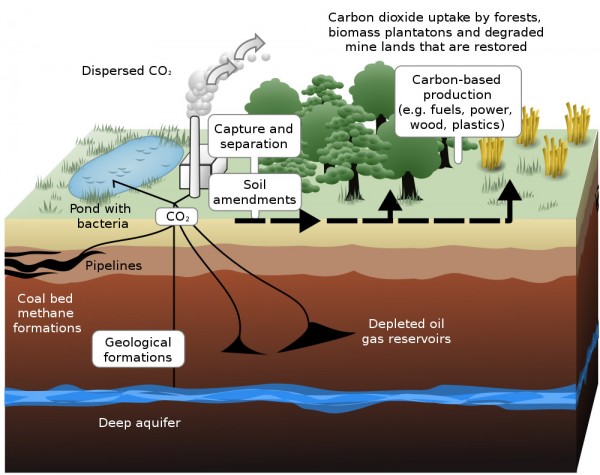Yaoyao Hu, MEL Candidate | December 2020
APPP 506 – Master of Engineering Leadership Capstone Project, University of British Columbia

ABSTRACT:
This capstone project is called Carbon Capture and Storage Phase II. In light of the recently declared Climate Emergency at UBC, carbon capture and storage and utilization technology is a necessary pathway to transition UBC’s District Energy System to Zero or Negative Carbon emissions. This project will build on a literature review of current carbon capture and storage technology by providing in‐depth feasibility and the financial estimate of installing various Carbon Capture Storage technology as well as a sensitivity analysis. Additional outputs include providing NPVs on different timescales and using different carbon tax progression rates.
INTRODUCTION:
This capstone project is one of the University of British Columbia SEEDS (Social Ecological Economic Development Studies) Sustainability Program, which creates applied research and interdisciplinary partnerships between students, faculty, staff, and community partners to advance sustainability ideas, policies, and practices and create societal impacts by using the Campus as a Living Laboratory.
BACKGROUND:
Due to the carbon emissions that will lead to climate change worldwide, this capstone project aims to reduce carbon emissions. This capstone project seeks to realize the carbon resource utilization sustainability as renewable clean energy to react to the global warming issue.
Metro Vancouver has adopted a Climate Emergency Declaration, a call for action that will result in strong policies and programs being enacted to mitigate both corporate and community carbon emissions. Nowadays, the world has an exciting and challenging carbon emission reduction as a significant part of minimizing climate change. The carbon capture and storage technology will play a key role in ramping up the response to the climate emergency in its beginning stages.
PROJECT MENTORS:
Dr. Vladan Prodanovic, Associate Professor of Teaching and Director MEL CEEN; Julie West, Sr. Energy Conservation Manager; James Montgomery, Energy Conservation Engineer
RESEARCH METHODS:
process model
life cycle analysis
Stakeholders management plan
Project risk management plan
Sensitivity analysis
Financial analysis
Financial assessment
CCS technologies review and comparison
RESULTS:
1 Potential partnership of carbon capture and storage companies list
2 Analysis and comparison of carbon capture and storage companies
2.1 Technology analysis2.2 Types of plants has the CCS technology been employed on to date
2.3 Technical details/schematics regarding capturing of CO2 from flue gas
2.4 Outputs analysis
2.5 Cost analysis
2.6 Capture scaling range for project
2.7 The advantages/disadvantages
2.8 Energy intensive process
2.9 Previous projects review and Current status of the project
DISCUSSION AND CONCLUSIONS:
| Company name | Email & phone &location | Capture Technology | cost | Output carbon product |
| CO2 solutions | info@co2solutions.com4188423456 Quebec | 1.carbonic anhydrase (CA) enzyme. The company was using the enzyme, at a very competitive operating cost. 2.1T1- a proprietary high-performance enzyme | The quantity of electrical energy required to operate the Unit translates into a cost of only C$7.35/tonne-CO2 (or less than USD 5.00/tonne-CO2). | Their technology can capture emissions to extract and purify 99.95% or more of the CO2 for reuse, and without producing any toxic waste. |
| Global thermostat | 16467986217 New York | GT uses custom equipment and proprietary (dry) amine-based chemical “sorbents” that are bonded to porous, honeycomb ceramic “monoliths” which act together as carbon sponges. These carbon sponges efficiently adsorb CO2 directly from the atmosphere, smokestacks, or a combination of both. The captured CO2 is then stripped off and collected using low-temperature steam (85-100° C), ideally sourced from residual/process heat at little or no-cost. GT plants are completely modular – from a single 50,000 tonne/yr. Module to a 40-Module, 2MM tonne/yr. Plant, and larger – a GT plant grows by adding more modules. GT Plants also have a small footprint – capturing from 20-500 tonnes of CO2/yr./m2 or more, depending on the embodiment used. | Low cost-Affordable & profitable without government subsidies or carbon credits. Easy to integrate with existing or new-built power plants. Small footprint: captures CO2 at hundreds of tonnes/year/m2.Carbon Negative: uses residual heat to capture more CO2 than power plants emit. | Plants can be Stand-Alone (Pure Air) or Co-Located with large emitters – both new & existing. In fact, integrating GT’s post-combustion process with an existing power plant is quite simple, and has been done with just a single day of power plant down-time. GT enables a true Carbon Negative electricity generation: a GT plant utilizes the residual heat of an adjacent fossil fueled power plant, while simultaneously capturing the CO2-rich flue gases it produces. This process allows the plant to capture substantially more CO2 than it emits. Similarly, GT can utilize the “harmful” heat by product of PV solar farms to power its plants, turning the farms into giant carbon sinks, while increasing their profitability through CO2 sales.Unlike some other green initiatives, GT requires no government subsidies or Carbon Credits to be economical and profitable. |
| Carbon engineering | Calgary | 1. Direct Air Capture (DAC) technology | 100dollar/ton | ultra-low carbon synthetic fuel |
| Clime works | contact@climeworks.com Zurich | Their CO₂ collectors selectively capture carbon dioxide in a two-step process. First, air is drawn into the collector with a fan. Carbon dioxide is captured on the surface of a highly selective filter material that sits inside the collectors. Second, after the filter material is full of carbon dioxide, the collector is closed. They increase the temperature to between 80 and 100 °C – this releases the carbon dioxide. Finally, they can collect this high-purity, high-concentration carbon dioxide. | 1. $75.00 ($75.00 × 1)Special Expedition Plan – 75 CAD monthly – 600 kg CO2 removal enabled per full year of subscription. Enable the permanent removal of 600 kg of carbon dioxide from the air per year.2.$32.00 ($32.00 × 1)Discoverer Plan – 32 CAD monthly – 255 kg CO2 removal enabled per full year of subscription. Enable the permanent removal of 255 kg of carbon dioxide from the air per year. | They have joined forces with the Icelandic company Carbfix. Carbfix has a strong scientific backbone and is one of the world experts in rapid underground mineralization of carbon dioxide. The Carbfix process centres around the Hellisheiði geothermal power plant, which provides the renewable energy they need to run the Climeworks machines. We remove carbon dioxide from the air with our direct air capture machines. Carbfix then mixes the carbon dioxide with water and pumps it deep underground. Through natural mineralization, the carbon dioxide reacts with the basalt rock and turns into stone within a few years. The carbon dioxide is thus removed from the air and returned to earth, permanently and safely. With our machine-based solution, we can exactly measure how much carbon dioxide has been removed and turned into stone. |
| Linde PLC | 8444454633 American- German, Irish-domiciled | CO2 Capture from Hydrogen Plants: Several options are available for capture of 50 to 90 percent of the CO2 normally emitted the option selected depends on the nature of future regulations, including allowance pricing. An allowance price or credit of $40 to $50/ton of CO2 (2005 cost basis including compression to 2000 psig and pipeline transportation of 10 miles) should be adequate to trigger investment for capture at the 50 percent level. | CO2 captured from a hydrogen plant is suitable for enhanced oil recovery (EOR) and underground storage in saline aquifers or depleted gas reservoirs. It is expected that levels of impurities such as water, nitrous oxide (NOx), sulfur oxide (SOx), and oxygen can be controlled to meet current and future specifications. Given the volume of CO2 captured from SMR-based hydrogen plants, it will be necessary to aggregate with other sources to cost effectively transport the CO2 to a sink. For example, the maximum CO2 available from a 100 MMscfd hydrogen plant with a 95 percent operating rate is 780,000 short tons per year. This quantity is far below the minimum economic threshold for pipeline transportation. |
CONTACT:

Yaoyao Hu phone: 2369826923 Email: huyaoyao2@gmail.com LinkedIn: www.linkedin.com/in/yaoyaohu
REFERENCES:
1. “Introduction to Carbon Capture and Storage – Carbon storage and ocean acidification activity”. Commonwealth Scientific and Industrial Research Organisation (CSIRO) and the Global CCS Institute. Archived from the originalon 8 December 2012. Retrieved 3 July 2013.
2. D’Alessandro, Deanna M.; Smit, Berend; Long, Jeffrey R. (16 August 2010). “Carbon Dioxide Capture: Prospects for New Materials” (PDF). Angewandte Chemie International Edition. 49 (35): 6058–6082. doi:10.1002/anie.201000431. PMID 20652916.
3. Rhodes, James S.; Keith, David W. (19 February 2008). “Biomass with capture: negative emissions within social and environmental constraints: an editorial comment”. Climatic Change. 87 (3–4): 321–328. doi:10.1007/s10584-007-9387-4.
4. “Climate change: UK carbon capture project begins”. BBC. 8 February 2019.
5.“News for the Business of Energy”. Energy Current. Archived from the original on 8 December 2008. Retrieved 2 April 2010.
6. “Australia’s largest carbon capture project gets underway”. energyefficiencynews.com. 27 October 2009. Retrieved 31 May 2010
7. “U.S.-Canada Clean Energy Dialogue (CED) | Department of Energy”. www.energy.gov. Retrieved 6 December 2018.
8. Canada, Natural Resources (5 June 2014). “Carbon Capture and Storage: Canada’s Technology Demonstration Leadership”. www.nrcan.gc.ca. Retrieved 6 December 2018.
9. “Alberta Carbon Trunk Line, Alberta”. Hydrocarbons Technology. Retrieved 6 December 2018.